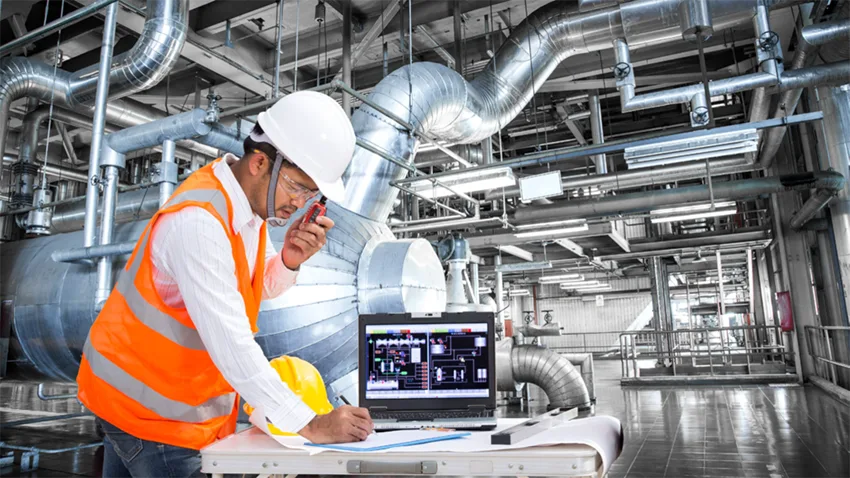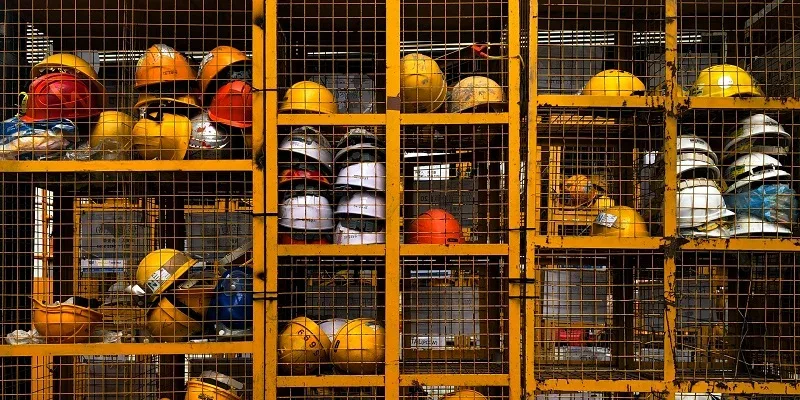工作場所安全在建築業非常重要. 建造, 全球最危險的產業之一, 導致數以萬計的短路- 每年都有長期傷害. 主要危險來自高處墜落, 高空作業佔 26% 工作場所致命傷害. 車輛和重物移動會帶來額外風險, 物體從高處墜落, 地下高壓輸電線, 密閉空間, 高噪音場景和灰塵 & 暴露於煙霧的地方.
本文將帶您了解如何使用 物聯網技術 可以顯著提高這些高風險地點的工作場所安全!
什麼是工作場所安全中的物聯網?

物聯網技術的應用 在工作場景中仍然是最先進的安全改進方法之一. 物聯網有利於企業優化工作條件, 收集數據資訊, 簡化營運並提高生產力.
物聯網設備無法為危險領域的工人提供全面保護. 相反, 它們有助於管理者應對大量可以避免的風險. Institutions are enabled to supervise and detect working conditions and the health of staff through IoT technology which is helpful to reduce the contact of risk areas for employees, so as to avoid accidents.
2. 物聯網如何增強工作場所安全

(1) 監控潛在風險
One of the features of 物聯網軟體 lies in predictive maintenance, which can be applied to monitor devices in workplaces. It gives more leeway for people to observe structural failures of any device connections before accidents occur. With the help of predictive maintenance, machine learning algorithms are helpful to predict potential issues before it exerts influence on staff. The strength rests with helping institutions take active action on the basis of data models.
IoT and data analysis technology bring about more centralized and integral monitoring, 測試和分析數據,而不是分散和手動數據和報告分析. 擁有更有效的系統, 組織能夠獲取有助於監控的完整訊息, 檢測和預防公司面臨的潛在危險.
(2) 提高安全性
引入員工培訓計劃將有利於識別潛在的安全風險. 這樣, 工作環境可監控, 透過物聯網技術維護與記錄,確保安全. 透過分析和利用數據, 物聯網技術可以為員工提供職業健康和安全策略,保證 工作場所安全 在很長一段時間內.
例如, 可以藉助物聯網工具的整合來制定工廠員工的工作時間表, 人力資源, 和勞動力解決方案, 這可以最大限度地減少安全威脅或確保 24 每位員工的輪班時間. 如果出現以下情況,就可以發現潛在風險: 物聯網設備 工作場所安裝有環境感測器. 該感測器還可以幫助員工更多地了解工作場所. 如果他們清楚自己的工作場景,那麼事故的發生就會降低。.
部署在工作場所的物聯網監控設備可以為員工提供協助, 幫助他們確保安全的工作場景. 即使在緊急情況下,連接的設備仍能正常運作, 以確保他們的安全.
(3)追蹤員工健康狀況
透過健康監測技術對員工進行最新的身體檢查和公司資產的檢查(主要是穿戴式裝置) 有助於提高工作場所安全. 案例包括: 員工可以配戴公司提供的可連接物聯網伺服器的手錶. Then the data sent by the servers are useful for them to come up with safe decisions. The wearable technology targeted at staff is conducive to optimizing the health and safety of workplaces, enhancing the visibility of operations, simplifying procedures, as well as boosting safety & efficiency, so as to carry out on-site measures. 在這種情況下, IoT tools have offered benefits, including the intensified operational efficiency of enterprises and a stronger sense of safety for staff. All of these can not only encourage more staff but increase productivity.
In special cases such as accidents, IoT devices with geolocation functions can also guarantee the exact location of employees, thus carrying out relevant rescues. 有設備可以即時收集事故周圍的重要信息,以便救援人員能夠快速評估情況,制定有效的救援計劃.
(4) 預防火災事故
工作場所發生火災事故是常有的事,但如果及早發現,還是可以預防的. 消防安全感知器可以偵測升高的溫度, 這表示火災有可能蔓延. 物聯網軟體加強了溫度升高的檢測, 這對防火非常重要. 使用物聯網軟體或配備消防安全感測器的設備, 組織可以偵測到溫度升高, 這表示工作現場可能發生火災. 早期發現對於及時疏散工人和實施關鍵預防措施起著至關重要的作用. 綜觀盛哲科技物聯網專案工作經驗, 火災偵測器和 物聯網感測設備 針對能源、危險氣體等隱患, 在即時感測中發揮著至關重要的作用, 二級警告, 遙控, 協助救援, ETC. 技術應用支援的解決方案為工業園區和建築的安全穩定運作提供長期保障.
(5) 加快救援速度並提高救援效率
發生事故時,借助物聯網設備可以快速採取救援行動.
例如, 物聯網設備 地理定位功能可以提供員工準確的位置, 這對於救援行動至關重要. 有些設備可以讓您收集重要的即時訊息,以便救援團隊能夠快速評估情況並制定有效的救援措施.
3. 物聯網在工作場所的困難是什麼

(1) 技術標準的統一與協調
現在, 物聯網無法融入傳統互聯網標準. 感知層物聯網包含異質數據,不同設備有不同的介面和技術標準; 由於所使用的網路類型和產業應用方向不同, 網際網路和應用層還包括各種網際網路協定和系統架構. 目前物聯網面臨的困難在於統一的物聯網體系架構和技術標準的構建.
(2) 平台管理
是一個複雜的網路系統, 物聯網由於其廣泛的應用領域,不可避免地會遇到一些重疊的部分. 如果這個網路系統沒有專門的資訊整理管理整合平台, 會有大量的冗餘訊息, 重複性工作和施工, 這導致了資源浪費的產生. 物聯網的優勢並不能透過各領域獨立應用等特質來體現, 成本高、效率低, 這必將影響物聯網的普及. 現在, 物聯網迫切需要一個能夠整合不同產業各類資源的統一管理平台, 打造產業鏈一體化模式.
(3) 成本
現在, 各國積極支持物聯網. 每個國家看似全方位的發展環境, 很少 物聯網專案 有機會投入實際使用並且廣泛應用. 案例包括電子標籤和閱讀器, 實現了最基本的RFID技術, 其價格超出了許多企業的預期,不划算. 特色多跳, 感測網絡是一個自組織網絡, 容易因環境和人為因素而損壞. 所以, 如果需要平穩運作並安全地傳遞可靠的即時訊息,這種網路的免維護性就會很高. 如果成本不能被普遍接受,那麼物聯網的成長就毫無意義.
(4) 安全
傳統互聯網發展成熟並大規模應用,但仍有安全漏洞. 作為新興產品, 物聯網架構相對複雜,沒有統一的標準. 也, 各方面仍存在一些突出的安全問題. 其實現的關鍵技術在於感測網絡. 感測器等暴露於自然環境的情況, 尤其是那些放置在惡劣場景的, 如何長期保持網路完整性為感測技術帶來了新的挑戰. 這意味著感測網路必須具備自恢復功能, 它不僅受環境因素的控制,而且還受到人為因素的嚴重影響.
4. 物聯網保障工作場所安全案例

公司已整合物聯網技術以進一步降低工作場所的風險. 這些技術結合了即時分析, 機器學習, 高度發達的感測器和系統,具有嵌入式結構,支援許多關鍵功能.
生理監測
應用穿戴式科技即時監測員工生理狀態. 禦劍, 一家擁有穿戴式科技的日本公司, 在該領域表現活躍. 該公司開發了一種由編織金屬銀纖維製成的智慧衣服,可以收集有關穿著者的大量數據, 例如心率和身體溫度. 其他產品包括帶有生物感測器的腕帶,可以精確測量壓力水平,以及可以檢測眼球運動以識別疲勞和微睡眠週期的眼鏡.
環境監測
用於測量溫度等危險化學品的感測器, 輻射, 瓦斯洩漏和一氧化碳, 可自動提醒工作人員注意不安全的外部環境. 更重要的是, 視覺成像軟體可以3D繪製工人的工作環境,促進主管和現場人員之間的有效雙向溝通,並透過遠端指導為處於嚴重危險環境中的工人提供即時幫助 (例如, 引導被困隧道中的礦工找到最佳出路).
態勢感知, 訓練 & 行為數據
擴增實境 (擴增實境) 技術透過物理設備提供的全像圖提供了支持決策的新方法. 相反, 虛擬實境 (虛擬實境) 科技提供沉浸式情境訓練,沒有現實世界中的相關風險. 這些技術還提供有價值的行為數據,可用於評估工人的風險承受能力和應對危險的能力.
接近檢測
接近偵測系統利用穿戴式感測器來監控工人的位置,以了解他們的活動並對附近的威脅發出警告. 一種情況是 射頻識別 (射頻識別), 它測量工人和移動設備之間的距離,然後警告他們可能發生的碰撞. 另一種設備是“智慧頭盔”,「它可以即時檢測事故,識別工人的位置並向安全控制中心發送座標警告, 然後透過影片進行聯繫 & 與工人進行音頻和溝通,直到他們獲得幫助.
外骨骼
透過分析工人的活動並提供必要的支持, 外骨骼可以幫助舉起重物並預防肌肉骨骼疾病. 例如, 工廠車間工人使用的隱形椅子固定在背部和腿部,為工人坐著或蹲著時提供支撐. 更重要的是, 外骨骼用於檢測工人的運動,以識別重複運動和持續過度勞累的時期.
5. 工作場所安全的物聯網解決方案

(1) 更快的緊急回應
當工作人員遇到突發事件時,立即向指揮中心報告, 可以採用預定的自動化工作流程來加快疏散和救援事件. 例如, 當工人從高處墜落或突然暈倒時, 安全控制中心將啟動警報,以便及時啟動醫療救助. 同樣地, 如果空氣中的某種氣體含量超過可接受的閾值或監測到即將發生爆炸, 立即通知工作人員並迅速撤離危險區域.
(2) 改善工人健康和生產力
工作環境可見度的增加也有助於避免長期暴露在二氧化碳等惡劣條件下, 輻射, 噪音, 炎熱或潮濕. 感測器數據使管理人員能夠觀察任何疲勞跡象, 脫水, 或員工經歷的疲憊,因此可以激勵他們根據需要休息. 在最低水準上減少過度勞累不僅可以提高整體生產力,還可以降低受傷的危險, 意外和慢性病.
(3) 診斷並預防未來的事故
除了反應性反應, 由大量現場感測器數據支援的可預測分析可用於提前預測和預防風險. 例如, 安裝在岩錨上的智慧感測器可以檢測地下礦井中的地震活動,並監測不穩定礦井中可能發生的崩塌. 如果發現風險, 禁止在這些地方進行作業或採取預防行動計劃,以防止事故.
相似地, 狀態監測和可預測維護將泵浦和管道等關鍵資產的故障減少到最低水平,從而降低氣體洩漏爆炸風險. 遠端追蹤可以識別未使用的功能正常的重型機械並將其關閉, 這有助於避免設備事故並提高效率.
前提: 全方位現場互聯網連接
在所有巨大的潛力中, 實施物聯網員工安全解決方案的一個主要困難在於找到可行的現場連接. 多處高風險工業區, 例如建築工地, 植物, 海上鑽井平台和地下礦山, 地形複雜, 重大物理障礙和廣大區域. 這些不利條件會導致陰影, 衰減, 可能阻礙有效無線電傳播的繞射和反射.
低功耗廣域網 (低功耗廣域網) 提供廣泛和深入的建築滲透, 為地理位置分散、建築密集的工業園區提供多功能通訊解決方案. 超低功耗也延長了電池壽命, 將低功耗廣域網路開發為連接由電池供電的物聯網裝置(例如穿戴式裝置和環境感測器)的實用解決方案.
















